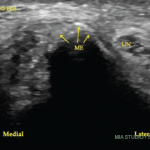A 65-year-old established female patient returns to the office for a follow-up visit for her diagnosis of fibromyalgia. She complains of pain, stiffness and swelling in her left hand, elbow and neck that is persistent since her last visit. The pain is considerably worse in the morning. She denies any fevers, cough or dyspnea. The physician performs an expanded problem-focused exam.
A two-view X-ray of the left hand is performed, and the results are read during the visit. The hand X-ray is negative. Because of the severity of the neck and upper back pain, the rheumatologist decides to give five trigger-point injections, including the right and left trapezius, right and left rhomboid and right paraspinal muscles. No medication was changed for the patient.


